Contact
ONSENCOM INC.2-5-2, Motoyokoyama-cho, Hachioji-shi, Tokyo-to, 192-0063, JAPAN
Free-flowing hot spring water means that the hot spring water is constantly poured into the bathtub, and the overflowed water is directly discharged. Of these, when the source is poured directly into the bathtub without any water heating, water adding, or disinfection, it is called “100% natural free-flowing hot spring water”.
In this case, the temperature of the water is controlled only by the amount of water poured into the bathtub, making it difficult to adjust the temperature delicately. Yet, there are some inns that stubbornly adhere to do. In fact, it is said that only about 1 to 3% of all hot spring inns are doing in this way.
 |
This 100% pure hot spring is controlled by not adding water to lower the temperature, but lowering the temperature by dipping the pipes from the source to the bathtub in a cold water such as a river (heat exchange), or by squeezing the volume of the hot spring water that is poured into the bathtub. You can see the hot spring water overflowing from the bathtub as new spring water is always poured into the bathtub.Also, temperature controlled by heating water without adding water has almost no effect on the hot spring components, it can be said to be 100% natural free-flowing hot spring water.
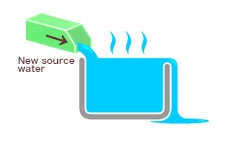
 |
In the case of high-temperature hot springs, water (tap water, well water, etc.) is temporarily added to adjust the temperature depending on the season, such as summer. The hot spring water component will be slightly thinner by adding water. In winter, the outside temperature is lower, so the hot spring water becomes “100% free-flowing”.
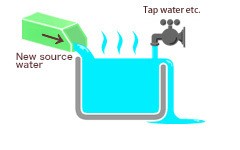
 |
Due to the high temperature hot springs, water is always added to regulate the temperature of the hot spring, regardless of the season. In some cases, water is purposely added to hot springs that are rich and highly stimulating (Acidic springs, Sulfur springs, and other hot springs with special components). By adding water, the hot spring components become thinner.
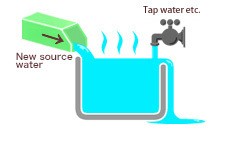
 |
※100% at the source |
This is often the case at inns that draw hot spring water into the bathtubs in guest rooms. For example, when you check in, the bathtub is empty, but when the faucet is turned on, hot spring water comes out. If you fill the bathtub with hot water as it is, the water is often hot, but we recommend that you fill the bathtub with a certain amount of hot water and let it cool down without adding water, so you can bathe in 100% natural hot spring water. It is ideal for those who want to bathe for a long time or for skin treatment, as they can bathe at their own preferred temperature.
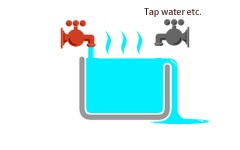
 |
While fresh hot spring water is poured into the bathtub, the hot spring water is inhaled in the bathtub, filtered to remove impurities, disinfected with chlorine, and then the hot spring water is returned to the bathtub for reuse. In many cases, public bathhouses in hot spring areas with abundant hot spring water has been newly reconstructed and turned into this type of hot spring system under the guidance of the health department.
In this case, the temperature of the hot water can be easily adjusted by computer control. This is common in hot spring areas in local governments that prioritize sanitary issues, such as the prevention of Legionella bacteria outbreaks. In large public baths where an unspecified number of people bathe, many prefer this method from a sanitary standpoint, as some people do not shower adequately before entering the bath. This system is common in large hot spring facilities, but it is also becoming more common in smaller inns with
smaller amounts of hot water. The fact that temperature control can be left to the computer has also spurred
widespread use. This is the most common system used in Japan. In some facilities, not only fresh hot spring
water but also recycled hot spring water is poured from the hot spring faucet above the bathtub, so drinking hot
spring water directly from the faucet is prohibited.
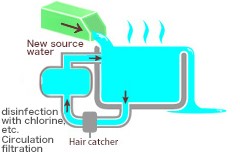
 |
This system reuses hot spring water by constantly inhaling it from the bathtub, filtering it to remove impurities, disinfected it with chlorine, and returning the hot spring water to the bathtub again.
In some cases, although there is a hot spring source, the amount of hot water is low, and the amount of hot water is increased by adding water, or there is no source well nearby, and the hot spring is brought in by tanker trucks or other means, so-called “carried-in water” hot springs.
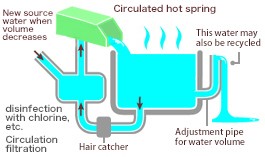
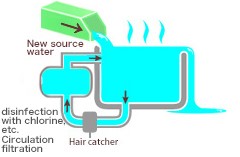
※In the illustration, the hot spring outlet (the exit from which hot spring water is poured) is drawn at the top of the bathtub for ease of understanding, but some facilities have an outlet inside the bathtub.
There are various reasons for this, such as the temperature of the spring is not so high and preventing the hot spring from cooling down.
In some cases, if the outlet is on the top of the bathtub and the spring water is free-flowing, the outlet may be placed inside the bathtub to soften the situation where the spring temperature is high only at the top of the bathtub and lukewarm at the bottom.
※In the illustration, the hot spring water is represented as overflowing from the bathtub, but as shown in the last illustration, some facilities have installed hot water volume adjustment pipes so that the hot spring water does not overflow from the bathtub on purpose.